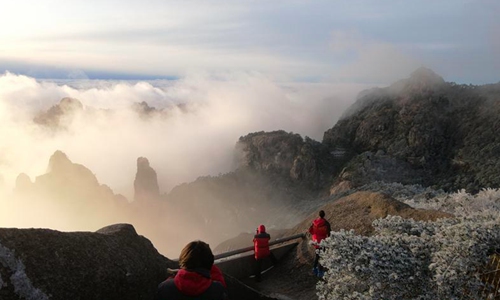HOME >> CHINA
Lesson from Huangshan Geopark
By Yin Yeping and Ji Yuqiao Source:Global Times Published: 2020/4/6 23:33:40
Scenic sites to face new challenges as demand rebound

Photo: cnsphoto
The coronavirus epidemic has eased significantly in China and many public attractions are gradually re-opening to visitors, but the tourism industry now faces dual challenges - surging demand on the one hand and prevention and control of the waning outbreak on the other.
Experts said that China's scenic spots must do a good job in terms of flow control and information monitoring to assure that the tourism industry resumes operation in a steady and safe manner.
Two days before the Qingming holiday, tens of thousands of visitors crowded at Huangshan Mountain, which is a world cultural and natural heritage and the world geopark and a 5-A attraction in East China's Anhui Province.
With a daily limit of 20,000 people, the park was already at capacity at 8 am, after the launch the fortnight free admission period for local residents on April 1-14. In order to control the flow, the scenic spot urgently issued announcements to stop more people from entering the park.
Yang Jingsong, a senior researcher at the China Tourism Academy, said that the Huangshan scenic area did not strictly follow the guidelines of the Ministry of Culture and Tourism, otherwise such a crowd could have been avoided.
"Many tourists found it hard to get into the scenic spot after spending hours stuck in traffic, which was the result of the lack of timely information," Yang said, adding that Huangshan should inform the public in advance and direct visitors to surrounding scenic spots to ease the jam.
Wearing a mask is a basic preventive and compulsory measure for every individual when doing outdoor activities, but on the opening day of Huangshan Mountain, many people got into the scenic spot without wearing a mask, Yang said.
"It is important to meet the demand of tourists but also to consider their safety, " Yang said.
Zhou Zijun, a professor at the Peking University School of Public Health, told the Global Times on Monday that crowds gathering in these scenic spots tend to have high risks in virus transmission.
"Chinese people do not have immunity to the coronavirus, so it is easy to be infected," Zhou said. "Also, there are some asymptomatic patients who are difficult to be identified, increasing transmission risks when many people gather in one place."
Recently, many people have posted photos of spring outings in Beijing's Chaoyang Park. Netizens expressed concerns after they noticed a large number of foreign students were not wearing masks in the park. Although the administration of the park later responded that it had taken measures to prevent such cases, experts believe more needs to be done as the outbreak is not completely over.
Parks "should continue to try to control visitor flow rates at any time according to their scales," said Zhou.
RELATED ARTICLES:
Posted in: SOCIETY,CHINA FOCUS